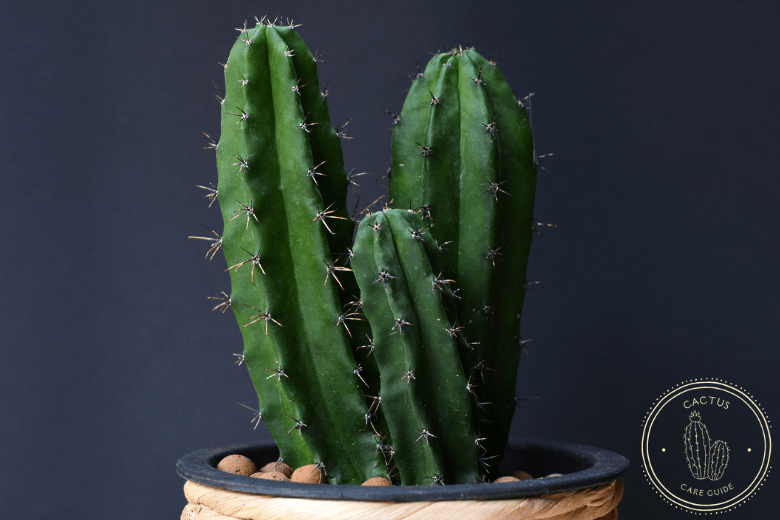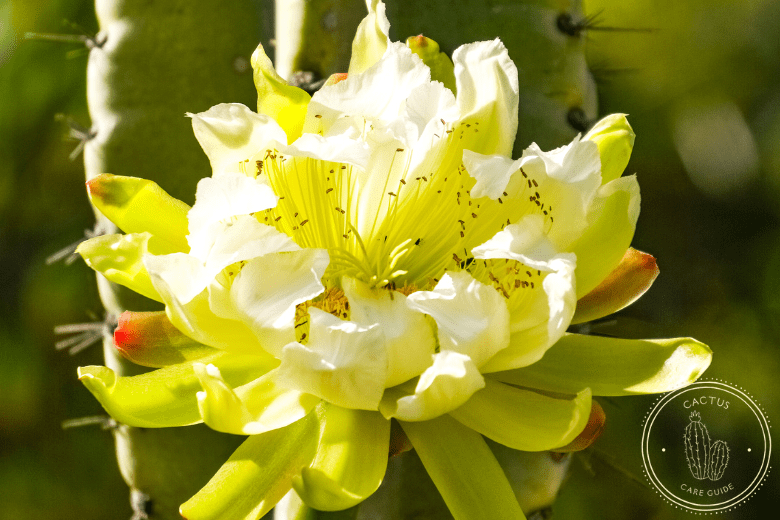Cereus Cactus Care: Nurturing the Peruvian Apple Cactus
Among the captivating and exotic plant life, the Cereus cactus stands as a botanical gem, particularly the enchanting Peruvian apple cactus. Known for its distinctive features and night-blooming tendencies, this beauty has found dedicated fans all over the world.
In our comprehensive yet easy guide, we will explore the peculiarities of caring for Cereus peruvianus, paying close attention to the vital aspects that ensure the flourishing of these remarkable succulents.
Embark on a journey with us as we uncover the secrets to cultivating a thriving Cereus cactus, navigating through the rich tapestry of its natural environment, and learning the art of balancing light, soil, and water to unlock the full splendor of this captivating member of the cactus family.

Cereus cactus: flourishing in its natural habitat
To truly understand the intricacies of caring for Cereus cactus, one must delve into the natural environment that has shaped the evolution of these fascinating succulents.
The Peruvian apple cactus, scientifically known as Cereus peruvianus, and its fellow Cereus cacti, like Cereus repandus, are native to South America, with its breathtaking landscapes.
South America, with its diverse climates and terrains, provides a varied canvas for the Cereus cactus to thrive. From the arid landscapes to the tropical regions, these cacti have adapted to a range of conditions.
The bright light of southern sunsets not only fuels the cactus’s growth but also triggers its mesmerizing night-blooming behavior, adding to the allure of these unique plants.

If you decide to become a Cereus cactus owner
Embarking on the journey of cultivating a Cereus cactus, especially the enchanting Peruvian apple variety, involves careful consideration.
Whether you’re a seasoned plant enthusiast or a burgeoning green thumb, the following step-by-step guide will shed light on the art of creating an ideal home for your Cereus cactus.
- Pot selection for optimal drainage
Commence your planting journey by selecting a pot with adequate drainage holes, a crucial feature to prevent waterlogged soil and potential root rotting. Ensure the pot’s size accommodates the cactus’s current dimensions while allowing room for future growth and there are enough drainage holes not to keep the soil dry on the one hand, and to prevent excess water from remaining in the pot.
- Selecting a well-draining potting mix
Crafting a potting medium that promotes excellent drainage is pivotal for the health of your cactus. Blend standard potting soil with elements like peat moss, creating a mixture that facilitates water movement and aeration. Consider using a specialized cactus and succulent mix for an optimal balance of nutrients and porosity.
- Transplanting with care
Gently extract the cactus from its nursery pot, taking special care not to disturb its delicate roots. Although we recommend getting rid of the dead roots, you won’t need them. Center the cactus in the new pot with the potting medium, ensuring even distribution of the plant’s roots. Surround the base with the prepared potting mix, securing the cactus in an upright position.
- Harnessing the power of light
Place your freshly pot-bound cactus in a location that receives bright, indirect light. While these cacti thrive under direct sunlight in their natural environment, introduce them gradually to indoor light conditions to avoid potential sunburn.
Maintenance: effective solutions
As you begin the journey of Cereus cactus care, remember that maintenance is an ongoing process. Enjoy it, be diligent, and your cactus will thank you with its gorgeous blossoms.

Proper lighting for your cactus
The right lighting conditions stand out as a pivotal aspect of the well-being and vibrancy of your cactus.
Understanding what enough light means for these enchanting succulents will ensure their continued growth and the stunning display of their night-blooming beauty.
Embracing bright, indirect light: in their native South American habitat, Peruvian apple cacti thrive under direct sun light. However, when cultivating these plants indoors, it’s crucial to introduce them gradually to bright, indirect light to prevent sunburn.
Place your cactus in a location where it receives ample, filtered sunlight.
Balancing indoor and outdoor exposure: to mimic the varied lighting conditions of their native habitat, consider occasionally placing your cactus outdoors.
This exposure to direct sunlight, even for brief periods, can enhance the plant’s overall health.
Monitoring light intensity: observing the intensity of light your cactus receives is crucial. A healthy Cereus cactus will exhibit vibrant green hues, while insufficient light may result in a pale or yellowish complexion.
Adapting to seasons: as seasons change, so do the lighting conditions. During the growing period, which typically aligns with spring and summer, your cactus will benefit from increased exposure to light.
Night-blooming rituals: one of the captivating features of the cactus is its tendency to bloom at night. To encourage this mesmerizing display, ensure the plant experiences a consistent light-dark cycle.
Avoid exposing it to artificial light during the nighttime hours, allowing the cactus to embrace its natural nocturnal flowering rhythm.

Watering your cactus
Mastering the art of watering is paramount to ensure the health and vitality of your plant. These succulents, native to the diverse South American landscapes, have specific watering needs that, when met with precision, lead to a flourishing display of their unique beauty.
Cereus cacti, including the Peruvian apple variety, thrive in well-draining soil. Allow the top layer of the potting mix to dry out between the waterings.
Excess watering can cause the risk of soggy soil, a condition that can lead to root rot and other complications.
Regularly assess the moisture level by inserting a finger into the soil — water only when it feels dry to the touch and there’s no excess water.
When the time comes to water your cactus, ensure thorough watering with the liquid penetrating the entire depth of the pot, reaching the plant’s roots.
This encourages a robust root system and prevents the formation of dry pockets within the soil.
While it’s essential to maintain well-drained soil, avoid extremes. Frequent watering without overdoing it will ensure your cactus is happy, and there are no risks to its health.
To refine thorough watering practices, pay attention to the moisture needs of the potting mix. Use a moisture meter or simply assess the soil with your finger.
Consistency in monitoring and adjusting your watering frequency ensures that your cactus receives the hydration it requires.

Humidity and temperature for your cactus
These enchanting succulents have specific preferences when it comes to their environmental conditions.
Native to regions with varying levels of humidity, the Peruvian cactus is remarkably adaptable. Aim for moderate humidity, especially if you’re cultivating your cactus indoors.
Adequate humidity supports overall health and prevents issues such as dryness in the soil.
While these cacti are generally resilient, excessively dry indoor air can impact their well-being. Placing a tray of water near the cactus or using a humidifier can help maintain an optimal level of moisture in the air.
Recognize that humidity levels can fluctuate with the seasons. During the drier winter months, when indoor heating systems are often in use, be attentive to the moisture needs of your cactus.
Cereus cacti, including the Peruvian apple variety, can tolerate temperatures remarkably. However, they do have preferences that mimic the conditions of their native habitat.
Aim for a temperature range between 70 to 100 °F (21 to 38 °C) during the day. Nighttime temperatures can be slightly cooler but should generally remain above 50 °F (10 °C).

Fertilizing strategies for your cactus
The role of fertilizers emerges as a key player in nurturing the vibrancy and health of your cactus.
The Peruvian cactus benefits from a strategic and measured approach to fertilization.
During the growing period, typically in spring and summer, introduce a slow-release fertilizer. Providing a gradual release of nutrients, this slow-release organic fertilizer sustains the cactus’s growth without the risk of over-fertilization of the potted plant.
Opt for a balanced fertilizer specifically formulated for cacti and succulents. These blends typically feature a nitrogen-phosphorus-potassium (N-P-K) ratio suited to the unique needs of these plants.
Fertilize your cactus sparingly and adhere to a consistent schedule. Too much fertilizer can lead to nutrient imbalances and potential harm to the plant.
Aim for fertilizing every 4-6 weeks during the active growing season. In fall and winter, when the cactus experiences a period of dormancy, reduce or eliminate fertilization.

Guardianship against pests and diseases
Like any plant, Peruvian apple cacti are not immune to potential threats. Let’s explore how to monitor for pests and diseases, safeguarding the health and vibrancy of your plant.
Regular inspection is your first line of defense against potential invaders. Develop a habit of visually examining your cactus, paying attention to the stems, leaves, and soil surface. Early detection allows for prompt intervention and prevents the escalation of issues.
Fungus gnats are common pests that can affect the health of your cactus. Keep an eye out for small, flying insects around the plant and tiny black larvae in the soil. Fungus gnats thrive in moist conditions, making well-draining soil and controlled watering essential preventative measures.
Spider mites, although tiny, can wreak havoc on your night-blooming cactus. Watch for fine webbing on the plant, yellow stippling on the leaves, or a general decline in vibrancy. Regularly misting the cactus or wiping the leaves with a damp cloth helps deter these pests.
While Cereus cacti are generally resilient, diseases like root rot can pose a threat, especially in conditions of excess moisture. Ensure proper drainage, use a well-draining potting mix, and avoid overwatering to minimize the risk of fungal infections and diseases.
If you detect signs of pests or diseases, swift intervention is key. Isolate the affected plant to prevent the issue from spreading to others. For pests, consider using insecticidal soap or neem oil, and for fungal issues, adjust watering practices and, if necessary, apply a fungicide.
Our other useful guide: How to get rid of cactus bugs
A guide to pruning
Pruning offers the opportunity to sculpt and enhance the natural beauty of your Peruvian cactus. Let’s explore the ways to nurture the aesthetic appeal and overall health of your cactus.
The primary goal of pruning is to enhance the plant’s natural form, removing any dead or damaged stems while promoting a balanced and aesthetically pleasing appearance.
Begin by identifying the stems that require attention. Remove any stems that have become damaged, discolored, or are showing signs of disease or pest infestation.
Dead or wilted portions should be trimmed back to the healthy green tissue. Aim to undertake pruning during the growing season, typically in spring or early summer.
Arming yourself with the right tools ensures a precise and gentle pruning process. Use sharp, clean pruning shears or scissors to make clean cuts, minimizing the risk of injury to the plant. Sanitize your tools before use to prevent the spread of potential diseases.
Pruning stimulates the growth of new stems and branches. If you wish to encourage a fuller appearance, selectively prune certain stems, prompting the emergence of fresh growth. This can contribute to a lush and vibrant display of the Peruvian apple cactus’s distinctive characteristics.
After pruning, allow your cactus some time to heal. Ensure the cut surfaces have dried and calloused before exposing the plant to water or potential pests. This helps prevent issues like infections or rotting at the cut sites.
Final thoughts
Cultivating and nurturing your Cereus cactus becomes a synergy of thoughtful practices and attentive gestures. From the mesmerizing South American lands to the heart of your home, these charming succulents bring a touch of exotic elegance that deserves the utmost care and consideration.
The apple cactus, with its night-blooming beauty, fruit tasting like dragon fruit, and resilient spirit, invites you to become a custodian of its grace.
Through proper care, you not only ensure the health and vibrancy of your cactus but also create an oasis of natural beauty within your living space.
As you embark on this journey, remember the delicate balance of sunlight and shade, the rhythm of watering, and the harmonious combination of nutrients of the potting medium (don’t forget to add peat moss to the mix.)
May your Cereus cactus thrive under your dedicated care, showcasing its unique allure and becoming a living testament to the beauty that can be cultivated within the confines of your home.
You might also like:
? How to treat black spot on cactus plants

FAQs
How do you take care of a mini Cereus cactus?
Provide bright, indirect light. Use well-draining soil. Water when the topsoil is dry. Avoid overwatering. Keep in a warm environment. Fertilize during the growing season. Watch for pests. Trim dead or damaged stems.
How do you care for a night-blooming Cereus cactus?
Place in bright, indirect light. Water sparingly; allow soil to dry. Mimic natural light-dark cycles for blooming. Provide well-draining soil. Keep in warm temperatures. Fertilize during the growing season. Monitor for pests. Prune to shape and remove dead parts.
Is Cereus an indoor plant?
Yes, Cereus can be grown indoors. Ensure bright, indirect light. Use well-draining soil. Control humidity and temperature. Water sparingly, allowing soil to dry. Watch for pests. Prune for shape and health.
What kind of soil does a Cereus cactus need?
Cereus cacti prefer well-draining soil. Use a cactus or a succulent mix. Add perlite or sand for aeration. Ensure pH is around 6.0 to 7.0. Avoid waterlogging to prevent root rot.

Greetings, dear succulent lovers! I’m Jennifer West and I’m happy to share with you practical tips and guides on growing and caring for succulents, as well as all the magical facts about these unique plants. Grateful to have you on this green journey with me! Check out more about our team here.







